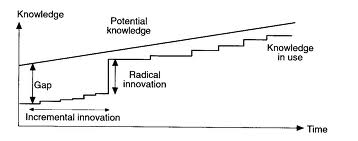Gilles Garel is tenured professor 
of the Chair of Innovation Management at the Conservatoire National des Arts et Métiers and professor with teaching responsibilities at the Ecole polytechnique.
Gilles conducts researches in the field of innovation and design management in collaboration with industry (the CNAM’s LIRSA team).
He kindly accepted to answer a few questions about his perception of innovation management evolution.
1 – Would you remind us about CNAM’s activities?
The Conservatoire National des Arts et Métiers (CNAM), or National Conservatory of Arts and Crafts, is a very unique French institution of long-standing and deep scientific tradition. The Cnam is a public institution of the French government, in the scientific, cultural and professional fields, with the status of “Grand Etablissement”.
The Cnam has been entrusted with three interconnected missions: lifelong education, research and innovation, dissemination of scientific and technological knowledge. Today Cnam is famous primarily as a continuing education school for adults seeking engineering and business degrees, proposing evening classes in a variety of topics.
More about CNAM at the end of the article.
2 – What is your role there and the mission of the Chair of “Innovation Management” ?
I’m working in the MIP department (Management, Innovation Prospective) of the CNAM Management and Society school and am involved in the new research center of CNAM in economics and management (LIRSA Laboratoire Interdisciplinaire de Recherches en Sciences de l’Action) founded in 2011, ingathering two former research centers (Greg en Lipsor) and about 60 researchers.
I was elected as CNAM Professor responsible for the Chair of Innovation Management in February 2010 and took up my functions there in 2011. In fact, Chairs, as people might know them or imagine them to be at CNAM, disappeared as part of a reform of the organization and governance of CNAM in 2010/2011. There are no longer any Chairs in the form of autonomous entities endowed with their own teams and projects. However, the (honorary) use of the title Tenured Professor of the Chair persists along with, more importantly, the possibility to work in an original higher education environment which combines research, further education, the dissemination of the arts and crafts, and all of this in an institution whose tradition of innovation goes back to the end of the 19th century.
In cooperation with my colleagues from the school of “Management and Society”, my aim is to develop, on the one hand, research activities in the field of innovation management within the framework of a new team that was set up in early 2011 (LIRSA, Laboratoire Interdisciplinaire de Recherches en Sciences de l’Action), and, on the other, master’s level and “made to measure” training courses leading to an improvement in the state of in-the-field research in the innovation management domain.
3 – What trends in the field of innovation management do you find particularly interesting today?
If we leave aside the financial and shareholder pressures associated with modern capitalism, we see that innovation today is characterized by three main trends which are profoundly transforming the way in which it is managed in a business context.
First of all, we can say that innovation today is intensive. What does that mean?
Innovation used to be localized whereas it is now becoming more widely dispersed. While, historically, innovation primarily took place in certain sectors characterized by specific techniques, markets or traditions in which creative staff and designers had an acknowledged place and status, and were expected to make a defined contribution based on known working methods, the picture today is more disparate. Every sector now strives for innovation and no business dare assume that it is innovating enough.
While innovation used to be rare and occasional, it is now becoming an everyday task. In the past, it was the source of occasional breaks with the norm separated by long periods of stability and progress took place at a more incremental rate. Nowadays, in our global marketplace in which every good idea rapidly spawns copies and the margins generated by one-off innovations are shrinking, medium-term success results from the continuous flow of powerful innovations. We are witnessing not only a challenge to the traditional opposition between “radical” and “incremental” but also the emergence of a new mode of operation in which the offer creates its own demand.
Enterprises which adopt these so-called “obsolescence” strategies aim to be the first to market with innovative offerings which downgrade existing products (including the enterprise’s own) and seek to satisfy constantly changing consumer demands before their competitors or before these demands shift once again. The focus is no longer on asking customers what they need but on being the first to offer them something which they might possibly want. Because it is impossible to predict the market’s response with certainty, you have to “pay to see”.
The consequence is the constant launch of large numbers of innovation projects accompanied by continuously shortening development times and product lifecycles. It is therefore necessary to maintain a short product renewal cycle while simultaneously introducing radical innovations whereas, in the past, these two strategies were long separated.
The second characteristic of innovation today is its increasingly collective and open nature.
Innovation no longer takes place at an individual or even a task force level. Instead, it demands broad-based collaborative systems involving competitors (e.g. ITRS in the field of semi-conductors), between customers and suppliers working together in joint innovation projects, or between the end customer and the enterprise. In recent years, the term “open innovation” has been used increasingly frequently to highlight these trends. For example, IBM is eighth on the list of worldwide holders of total patents in the field of… biotechnology. Another example: the automotive and telecommunications industries are working together in the development of onboard telematics systems.
A third characteristic relates to the uncertainty of identity introduced by modern-day innovation.
Intensive innovation is resulting in constant crisis regarding the identity of goods and services in many sectors of activity.
Traditional competition consisted of innovating in accordance with measurable performance criteria: faster, cheaper, smaller, safer etc. The business models were defined, the dominant designs and generally acknowledged product characteristics were stable and the skills required for development were known.
Now, however, the identity of objects has become uncertain in many sectors. Under the pressure of the spread of evolutive technologies, new social values, new regulations, financial rules and low-cost competitors, the identity of objects is constantly being revised.
The accessories that accompany new mobile products provide a good illustration of this instability of identity. After the telephone and the mobile, IT has invaded the world of cameras which in turn are now integrated in mobile phones. While watches have been worn by people on their travels ever since the 15th century, it is only very recently that they have become mobile libraries. What, today, is the function of a watch, a mobile phone, a television set? Where is the boundary between a foodstuff and a medicine? Is a free newspaper still a newspaper? When it first appeared in 2008, the iPhone transformed the identity of a mobile phone as it was then understood; can we really still talk in terms of telephony? Is the Vélib (a bicycle made available by the Parisian municipal authorities) still a bicycle?









Seems to sum up nicely the point we are at and the challenges within innovation we are facing.
Time / result compression
Uncertainty / Expectancies
Demanding / More open
Values / Disposable
Try it / Can it (drop it)- move on
Radical / Disruptive- forget incremental
Experimental / Prototyping quest
Thks Paul for being such a fast reader! Your points enrich the post, thks.
Unfortunately the 2nd part of the interview isn’t accessible… not published yet?
Thks for reading, part 2 will be online Friday